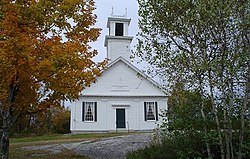New Durham, New Hampshire
| New Durham, New Hampshire | ||
|---|---|---|
| Town | ||

|
||
|
||
 Location in Strafford County, New Hampshire |
||
| Coordinates: 43°26′05″N 71°09′50″W / 43.43472°N 71.16389°WCoordinates: 43°26′05″N 71°09′50″W / 43.43472°N 71.16389°W | ||
| Country | United States | |
| State | New Hampshire | |
| County | Strafford | |
| Incorporated | 1762 | |
| Government | ||
| • Board of Selectmen | David Bickford, Chair David Swenson Gregory Anthes |
|
| • Town Administrator | Scott Kinmond | |
| Area | ||
| • Total | 44.1 sq mi (114.3 km2) | |
| • Land | 41.5 sq mi (107.5 km2) | |
| • Water | 2.6 sq mi (6.8 km2) 5.98% | |
| Elevation | 544 ft (166 m) | |
| Population (2010) | ||
| • Total | 2,638 | |
| • Density | 60/sq mi (23/km2) | |
| Time zone | Eastern (UTC-5) | |
| • Summer (DST) | Eastern (UTC-4) | |
| ZIP code | 03855 | |
| Area code(s) | 603 | |
| FIPS code | 33-51220 | |
| GNIS feature ID | 0873677 | |
| Website | www |
|
New Durham is a town in Strafford County, New Hampshire, United States. The population was 2,638 at the 2010 census. It is drained by the Merrymeeting , Cocheco and Ela rivers, and is known for Merrymeeting Lake. New Durham is home to the Powder Mill Fish Hatchery. Also located here is the Lions Club's Camp Pride, a camp for children and adults with special needs.
Granted by the Masonian Proprietors in 1749 as Cochecho Township, New Durham was settled in 1750 almost entirely by colonists from Durham. It would be incorporated as New Durham on December 7, 1762. With a somewhat uneven and rocky surface, the town was better suited to grazing than cultivation. Lumber became the chief article of trade, and by 1859 New Durham had five sawmills and four shingle mills. It also had two gristmills, and a gunpowder factory called the Eureka Powder Works. On September 19, 1849, the Cocheco Railroad opened through the town, connecting Dover with Alton Bay.
An early town minister, Reverend Benjamin Randall, founded a new religious denomination in 1780 called the Free Will Baptists, later known as Free Baptists. The church has two buildings in the community, the older built in 1819 on New Durham Ridge.
...
Wikipedia

